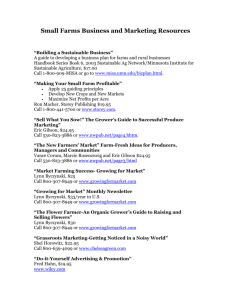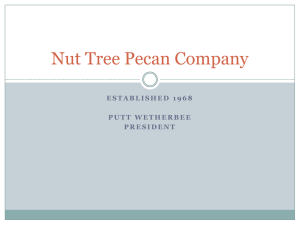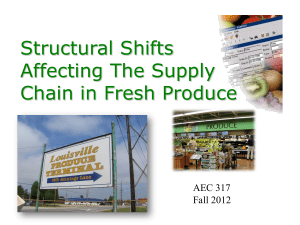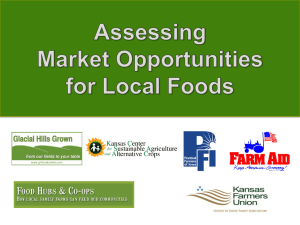Overview of Produce Marketing
advertisement
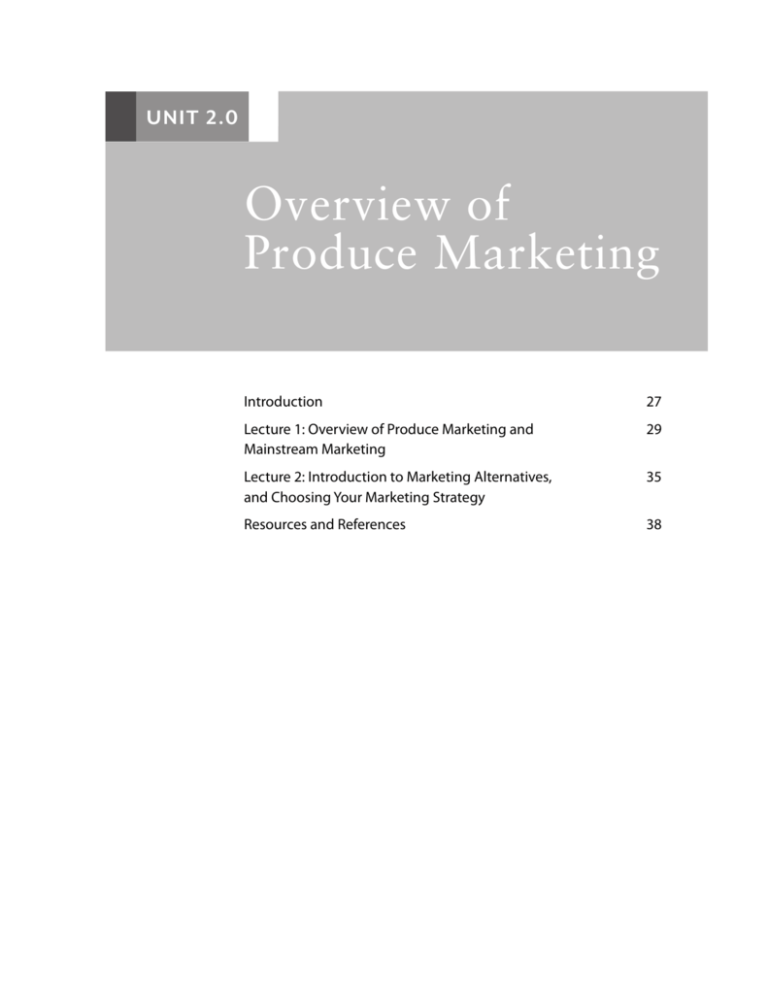
UNIT 2.0 Overview of Produce Marketing Introduction27 Lecture 1: Overview of Produce Marketing and Mainstream Marketing 29 Lecture 2: Introduction to Marketing Alternatives, and Choosing Your Marketing Strategy 35 Resources and References 38 26 | Unit 2.0 Overview of Produce Marketing Introduction: Overview of Produce Marketing UNIT OVERVIEW MODES OF INSTRUCTION The choice of a produce marketing channel is one of the most critical decisions produce farmers must make. This unit introduces students to the history of produce marketing and provides information on the most common marketing options. > LECTURES (2 LECTURES, 1–1.5 HOURS EACH) Lecture 1 provides an historical overview and discusses the changes growers made to their marketing practices after the advent of supermarkets and 20th century technology. It also introduces Agricultural Marketing Orders and their unique role in marketing produce. Three main conventional market channel options (wholesale buyers, grower/ shipper/packers, and brokers) are also reviewed, including their advantages and disadvantages for small-scale growers. LEARNING OBJECTIVES CONCEPTS • The recent history of produce marketing • Agricultural marketing orders and their role in produce marketing. • How produce distribution operates through the primary channels (wholesale buyers, grower/shipper/packers, and brokers) • The advantages and disadvantages to the farmer of deals involving wholesale buyers, grower/shipper/packers, and brokers • Three of the most common alternative marketing choices for farmers, and the advantages and disadvantages to the farmer of each choice • Key decision making points and tips for assessing which market channel is right for your farming operation Lecture 2 discusses alternative marketing options (Direct to Retail & Restaurants, Farmers’ Markets, and Community Supported Agriculture); these topics will be covered in detail in later units. The lecture concludes with questions to consider in choosing a marketing strategy. Introduction Unit 2.0 | 27 Overview of Produce Marketing 28 | Unit 2.0 Overview of Produce Marketing Lecture 1: Overview of Produce Marketing & Mainstream Market Channels A. Produce marketing is all the steps between when the crop leaves the edge of the field and when the end consumer purchases it 1. This includes your postharvest handling, building relationships with buyers, paperwork and accounting, telling the story of the farm and the farmer, branding and packaging, and promotion and advertising to the end consumer. B. Brief History of Modern Produce Marketing in the U.S. and Canada 1. Before refrigeration (1920s) – a) Produce farmers were scattered all over the U.S. and Canada and did most of their own marketing b) Local sales – Sales were direct to retail stores, at the farm gate, or at street markets c) Most items were unavailable to consumers during off-season d) Farm cooperatives, for either purchasing inputs or collectively marketing products, became increasingly important and significant. Federal and state legislation was passed to exempt farm co-ops from anti-trust laws and otherwise assist the efforts of farm organizations including the Grange, the National Farmers Union, and the Farm Bureau to establish farmer co-ops as a dominant marketing model. e) Farmers not selling through co-ops did everything including: farming, packing produce, selling, delivering, and collecting money. Few were (and are today) equally proficient at all these tasks. f ) Regional crop failures resulted in communities having nothing for people to buy in local markets. This provided an opportunity for long distance transport of produce to supply local markets. 2. Following the development of refrigeration, cheap transportation, synthetic pest control agents, and supermarkets (1940s) – a) Most farmers stopped doing the marketing themselves and instead specialized in growing crops. They hired professional marketing help, or began contract growing for specific wholesale buyers. b) Farmers began to increase their scale of production to take advantage of the economies of scale, producing fewer crops per farm unit. Cheap and effective pesticides and fertilizers enabled farmers to grow large monocultures with fewer crop rotations. c) Scale of production grew exponentially and production became concentrated in a few specific regions (e.g., apples in Central Washington, lettuce and cole crops in the Salinas Valley of California), each with its own infrastructure for production, packing, processing, and distribution d) Specialization – Businesses developed with specialized skills and/or equipment to take over harvesting, cooling, sales and delivery, etc. of fresh produce 3. Development of Agricultural Marketing Agreements and Orders (1940s–present) a) Federal Marketing agreements and orders were authorized by the Agricultural Marketing Agreement Act of 1937 and administered through the Agricultural Marketing Service of the USDA. Many states have marketing orders and agreements administered through the state’s department of agriculture. Lecture 1: Overview of Produce Marketing Unit 2.0 | 29 Overview of Produce Marketing b) Marketing orders are initiated by industry and financed through mandatory assessments on all shipment of the covered commodity and can include provisions that 1) regulate the volume of product marketed; 2) establish mandatory minimum quality, container, and pack standards; 3) finance generic advertising and promotion programs; and 4) sponsor production and marketing research. Marketing agreements are similar to marketing orders but participation is not mandatory. c) One aspect of marketing programs, often referred to as a “check-off” program, allows producers and/or handlers to pool their resources together to fund research, promotion, and advertising campaigns. Advertising campaigns such as “Got Milk?” and “Beef, it’s what’s for dinner,” were funded by these provisions. d) Historically the organic industry has not been able to fully benefit from such programs because agricultural marketing programs engage in generic marketing and promotion aimed at increasing consumption of a generic commodity. The price premium associated with certified organic products comes from the grower’s ability to assert a unique product, something worth more than the generic commodity version of the same crop. e) A provision in the 2002 Farm Bill was intended to exempt organic producers that “solely” produce “100%” organic products, from contributing towards their respective commodity specific promotion orders. The effects of this exemption were minimal because many farmers produce both organic and conventional products and the exemption only applied to federal marketing promotion programs. f ) The 2014 Farm Bill exempted all certified organic operations from the previous checkoff programs, and opened the door for the creation of an organic check-off program (see: www.organicaglaw.com/2014/02/2014-farm-bill-organic-checkoff-program-andorganic-crop-insurance/) 4.Summary a) Local production and sales are still the primary system in many parts of the world, but not in the U.S. and Canada b) Cheap and efficient refrigeration and transportation, plus the rise of supermarket outlets, lowered profit margins for most U.S. farmers and forced many regional farmers and small produce retail stores out of business (see Teaching Organic Farming and Gardening: Resources for Instructors, Unit 3.1, The Development of U.S. Agriculture for other issues contributing to consolidation of the food system) c) The growing consumer trend to “buy local,” has led to an increase in origin of produce labeling in retail stores. However, local production still remains a very small portion of total produce sales. C. Mainstream Marketing Options for Today’s Farmers: Advantages and Disadvantages 1. Mainstream produce market overview a) Mainstream market channels include: produce wholesalers, retail grocery stores, mass merchandizers, shipper/packers (or in some cases, grower/shipper/packers; see below), food service buyers, brokers, and export marketing channels b) Grocery stores sell the majority (70%) of fruits and vegetables c) Certified Organic produce is a growing segment within grocery stores; carrots lead with 17.1% of share of organic sales, followed by packaged salads, cooking greens, sprouts and lettuce. Among fruit, apples lead with 7.1% share of organic fruits sales, followed by berries and pears. d) According to the 2011 Organic Production Survey, organic sales include 81% wholesale market sales, 13% direct-to-retail sales, and 6% consumer direct sales e) While going through mainstream market channels is not frequently the best choice for new produce farmers, it is important to understand the full range of options available 30 | Unit 2.0 Overview of Produce Marketing Lecture 1: Overview of Produce Marketing 2. Wholesale produce buyers a) A wholesale buyer buys and re-sells or distributes produce to retail grocers, restaurants, food service companies, and/or other wholesale markets b) Wholesale produce distributors take custody of a grower’s produce once it is purchased. They sell produce from their warehouse and take responsibility for its care once it is received. c) Two goals of wholesale buyers are: to get product at the best price and quality and to get enough volume of the product to meet their customers’ demand. Wholesale buyers resell product to other wholesalers, produce brokers, retail stores, restaurants, schools or other institutions. d) Growers sell/market their produce directly to wholesale buyers e) Advantages of working with wholesale buyers i. Can move large volumes of produce ii. Don’t have to deal with end consumer directly iii. Transportation managed by wholesaler f ) Disadvantages of working with wholesale buyers i. Hard to keep customers— if not enough volume or year-round product ii. Need good market price information (can be hard to get) iii. Need on-farm sales office for customer service iv. Must bill customers and collect money v. Have to have own label, standard cartons and packaging, harvest crew, delivery vi. Produce may travel long distances, requiring farmer to have own cooler or arrangement with a cooler. It is critical that field heat be removed before produce gets shipped to the wholesaler to ensure the maximimum shelf life of your produce. vii. In the next few years expect to see steadily increasing barriers to entry into the wholesale market in the form of required GAP and food safety certifications and barcoding at the carton (if not item) level 3. Grower contracts with a grower/shipper/packer* a) The majority of fresh produce is marketed through grower/shipper/packers b) Originally started by individual successful growers going direct to wholesale. They built coolers, hired harvesters and salespeople, and offered their services to others. Over time, many grower/shipper/packers stopped farming and became service providers and farming partners. c) Today grower/shipper/packers may make contracts with independent farmers to provide services for everything needed after a given crop matures (e.g., harvest, pack, refrigerate, ship, sales, collections, etc.). The grower/shipper/packer usually provides 50– 60% of the money for growing costs. The farmer takes responsibility for just growing the crop. However, the grower/shipper/packer decides what crops to grow, how much, and when it needs to be ready. The grower/shipper/packer negotiates charges for services with the grower. The charges include the actual cost to the shipper, plus extra for profit. These charges are deducted from the gross sales returns with the remainder divided between the grower/shipper/packer and the grower in proportion to their shares of the growing costs. i. However, there is also a trend for grower/shipper/packers to hire farmers as employees to farm on the land they own or lease * Grower/shipper/packers can play slightly different roles and are often referred to by other names, such as grower-shippers or shipper-packers. In this lecture, we’ll use the term grower/shipper/packer even though not all of these entities do the growing or packing Lecture 1: Overview of Produce Marketing Unit 2.0 | 31 Overview of Produce Marketing d) Grower/shipper/packers are primarily handlers, essentially acting as marketing agents for growers e) In recent decades due to increased demand for year-round fresh produce, larger shippers have transitioned from seasonal to year-round operations, sourcing from shifting production regions, which follow climatically-determined seasonal patterns throughout the year. This means that many shippers market, and may invest in, production from several states and often other countries. f ) Grower/shipper/packers’ headquarters are fixed in the dominant production regions, and most are actually grower-shippers, large forward-integrated growers handling and marketing production for themselves as well as other growers. In this way they assemble a greater supply volume and come closer to matching the scale of the fewer, larger buyers that exist today, allowing growers of all sizes to gain access to major domestic and export markets. g) In meeting retail and foodservice demand for year-round availability, grower/shipper/ packers import produce during the off-season. Grower/shipper/packers apply their considerable expertise and technology to standardize product quality, employ Good Agricultural Practices (GAPs) and traceability mechanisms, and now increasingly social and environmental responsibility best practices; all of which must be achieved across each of a shipper’s growers and production locations, whether in the United States or abroad. h) The majority of grower/shipper/packers are based in California and Florida except in the case of apples, pears, and cherries; for these crops, firms located predominantly in the state of Washington. Online queries of a fresh produce industry credit reporting service, The Blue Book, showed that in 2011 there were 3214 total shippers in the United States, including 1259 in California and 465 in Florida (an approximation due to potential classifications of firms in multiple categories). i) In many areas it is difficult or functionally impossible for small farmers (especially those with limited English language proficiency, poor records, or poor credit) to obtain agricultural credit. Grower/shipper/packers can be a viable alternative since they may be accustomed to dealing with farmers. Unfortunately there are many examples of grower/ shipper/packers extending far more credit than a farmer could reasonably repay, and there are areas of the country where farmers end up increasing their debt to the packer year after year. j) Grower/shipper/packers are often more informed than banks about market fluctuations and have expert staff. By providing financing, grower/shipper/packers become farmer partners and make some growing decisions independent of the farmer, such as about which crop to grow, and how it will be grown. Farmers begin to lose significant control over their businesses. k) Economic advantage over farmers: Grower/shipper/packers make money on their services, even in marginal market circumstances when the farmers that they contract with are losing money on the crop sales. Grower/shipper/packers also have a larger financial base that can withstand temporarily deflated market prices for longer than farmers. l) Advantages of contractual arrangements between independent growers and grower/ shipper/packers i. Growers reduce their personal financial risk, as the grower/shipper/packer has an investment in the crop ii. Growers are able to take advantage of a grower/shipper/packers brand name, facilities, and advice iii. Growers can concentrate on farming—cropping system may be very simple 32 | Unit 2.0 Overview of Produce Marketing Lecture 1: Overview of Produce Marketing m) Disadvantages of contractual arrangements between individual growers and grower/ shipper/packers i. Growers are in competition with one another for the contracts with grower/shipper/ packers. This competition depresses the produce market and growers become pricetakers for the grower/shipper/packer services. ii. In response to the trend towards lower prices for wholesale produce, growers have increased their scale of production in an attempt to take advantage of the economies of scale. This, in turn, results in fewer farmers with more land, more start-up costs, more product, and thus more dependence on the grower/shipper/packer. iii. Although growers can concentrate on farming, they lose their independence and must farm in partnership with the grower/shipper/packer iv. Although just growing a few crops on large acres may be simple, it results in a loss of agroecosystem complexity and diversity, resulting in negative ecological consequences 4. Grower works with grower agents/produce brokers a) Grower agents are a subset of brokers that provide sales and coordination services for the farmer for a fee but usually have no investment in the farming. Grower agents try to get the best deal for the farmer and do not provide services for buyers. b) Non-grower agent are produce brokers who do not work for farmers, but put deals together between a farmer and a buyer. The broker finds product, finds a buyer, and puts the two together. Brokers can work for the buyer, or be an independent dealmaker, billing both buyer and farmer for putting the deal together. c) Brokers generally do not take custody of the product. They set up shipping from farms to their customers using trucks, planes, and at times boats. d) Brokers use their prior experience, skills, and connections to find potential buyers. Market knowledge of current market value and product availability determine what price to offer. e) Produce broker’s income is made in two ways – i. Fixed price for selling each unit of product. This can result in little incentive for the broker to pursue a high price for the grower because the broker gets paid the same regardless of price. ii. Broker percentage/commission derived from the sales price, typically 4–10%. This can results in little incentive for a broker to sell when market price is low because the broker gets very little commission for each low-priced unit sold. f ) Advantages of working with grower agents and produce brokers i. More independence than with a grower/shipper/packer ii. Freed up from the responsibility of sales and can concentrate on farming and harvesting iii. No splitting of profits with grower/shipper/packer g) Disadvantages of working with grower agents and produce brokers i. Farmer/grower needs to find his/her own financing ii. Farmer needs to provide delivery iii. Standard cartons and packaging required iv. High quality standards v. Grower agents expect a high degree of crop planning and predictable harvest vi. Low prices paid and high charges of brokers and grower agents can prove uneconomical for grower Lecture 1: Overview of Produce Marketing Unit 2.0 | 33 Overview of Produce Marketing 34 | Unit 2.0 Overview of Produce Marketing Lecture 2: Introduction to Marketing Alternatives, & Choosing Your Marketing Strategy A. Marketing Alternatives for Growers (see Unit 3.0, Community Supported Agriculture, and Unit 4.0, Other Direct and Intermediate Marketing Options, for information on implementing alternative marketing strategies) 1. The driving force behind alternative markets and marketing a) Some farmers are looking for higher profit margins and to sell at smaller volumes b) Consumers desire direct market relationships in order to – i. Have personal connection to farms and farmers ii. Provide direct financial support to farmers iii. Realize their perceptions of freshness, absence of pesticides, and farmworker safety c) Direct marketing alternatives are generally a more accessible market for new farmers 2. Examples of direct marketing a) Marketing directly to retail stores and restaurants (see Unit 4.2, Direct Marketing to Restaurants and Retail Outlets, for more information) i. Grocery retail stores may be large corporate chains like Safeway or Krogers, independent growers, or retail cooperative like Sacramento Natural Foods ii. Retail cooperatives are member-owned operations. They source directly from farmers, produce wholesalers, and distributors and may have their own central buying and warehousing facility. iii. Retail chains have introduced formal performance guidelines and food safety requirements for produce suppliers. The Food Safety Modernization Act, in the process of being implemented through the Food and Drug Administration, will set national standards for the growing and handling of produce entering wholesale or direct-to-retail markets. See more at Unit 7.0, Food Safety on the Farm. iv.Advantages • High prices • Less stringent standards than wholesaling—less difficult to get good market price information; less elaborate (or no) on-farm sales office because there are relatively few customers; less elaborate billing system, cooling, label, standard cartons and packaging, harvest crew, delivery because the products don’t need to travel a long way and customers do not require standardized packaging v.Disadvantages • Farmers need marketing skills • Fairly complicated, need much more infrastructure than with a grower/shipper/ packer • Limited market • Small amounts per customer • Customer service is most important, yet can be costly and difficult • Some supermarket chains are closed to local growers because they have yearround contracts with wholesaler distributors and grower/shipper/packer • The restaurant industry is characterized by rapid changes in personnel; the chef or a buyer can change suddenly, creating the need to constantly develop new relationships with potential buyers Lecture 2: Introduction to Marketing Alternatives Unit 2.0 | 35 Overview of Produce Marketing b) Farmers’ markets (see Unit 4.1, Direct to Consumers – Farmers’ Markets and Roadside Farm Stands, for more information) i. Major resurgence in recent years • At time of printing the USDA’s Agricultural Marketing Service reports as of National Farmers Market Week 2013, (the first full week in August), there were 8,144 farmers markets listed in USDA’s National Farmers Market Directory. This is a 3.6 percent increase from 2012. These data are updated every year. Check AMS website for current stats: www.ams.usda.gov/AMSv1.0/farmersmarkets. • The growth in farmers’ markets is a response to consumer trends of: n Shopping as recreation n Perceived freshness and quality n Consumers seek out their favorite farms and want to support them every week n Customer preference for personal attention ii. Advantages of farmers’ markets to growers • Opportunity to build relationships directly with end consumer • Enjoy higher margins on produce with instant cash flow • Exemption from pack standards reduces post harvest time and cost • Possible to use sub-standard product—consumers are more forgiving of cosmetic blemishes on fruit and vegetables • No special packaging or post-harvest handling requirements (other than what is required to make products safe and attractive) • Access to chefs • Farmers don’t always have to attend themselves iii. Disadvantages of farmers’ markets to growers • Good markets are often saturated/not accepting new growers, are highly price competitive and political • It can be hard to move large volumes of produce at small markets • Growers often must provide a high diversity or specialty crop to be accepted • Loading and offloading the truck combined with long travel times to markets can make for a long day • Need high degree of social skills to deal directly with a wide range of customer personalities c) Community Supported Agriculture (see Unit 3, Community Supported Agriculture, for more information) i. Individual consumers pay fee/purchase share at the beginning of the season and receive regular boxes of produce throughout the season when it is ready ii. Attracts sophisticated consumers who want to provide financial and other forms of support for regional agriculture iii. CSAs often afford the opportunity to visit the farm in order to confirm the land use practices employed iv. Requires an outreach plan to reach consumers and register for subscriptions v.Advantages • Solves pre-plant financing • Provides guaranteed market • No middlemen = greater potential profit • Potentially low capital costs 36 | Unit 2.0 Overview of Produce Marketing Lecture 2: Introduction to Marketing Alternatives • Moderate over and under supply can be handled by shareholders • Regular delivery schedule vi.Disadvantages • Complexity of cropping system—quality and quantity can be difficult as few farms can grow a wide range of high-quality product every week • Need high degree of social skills to deal directly with a wide range of customer personalities • Requires a high level of coordination and paperwork to manage subscriptions and logistics of delivery B. Choosing Your Marketing Strategy (adapted from Organic Marketing 101: A Guide for Getting our Products to Market, CCOF 2012) There are several market channels for your organic product. However, not all of them will fit with your goals, values, products and situation. To help identify the best marketing channels for your situation, start by reviewing the key assessment questions below to identify strengths and resources. Many organic growers find that diversity in marketing, just like diversity on their farm, is important to economic sustainability. These growers may do both wholesale and direct marketing, and cultivate a variety of customers and outlets. This diversity is limited mostly by their management capability. 1. Assess the strengths and weaknesses of your operation. Your strengths will help prioritize where to focus your energy in developing new markets. a) What are your strengths and core competences? What resources do you have? b) What are your weaknesses and challenges? c) How many markets do you currently work in? Do you have the desire and/or ability to expand? d) Who are your target customers? Where do they shop? 2. Assess your postharvest capacity a) Do you have a washing station with potable water and adequate drainage? b) Do you have access to skilled labor to harvest your produce? c) Do you have the right packing supplies for your target market channel? 3. Assess your transportation storage needs a) Will the buyer pick up product at your farm or will you need to pay a driver to do deliveries? b) Will you need to purchase a truck? Will it need refrigeration? c) What type of storage does your product need? Will it require a cooler or ice? d) How much space will you need for inventory? Do you have dry storage that is clean and rodent proof? 4. Understand the pack standards and packaging requirements for your market a) What are the packaging and postharvest handling requirements for the particular market? b) What are the labeling requirements? There is no magic formula to help you decide what market channel(s) is/are right for you. Consider the advantages and disadvantages of each market channel (more information on these topics are listed in Units 3 and 4 of this training manual), combined with your assessment of your strengths, resources, and infrastructure. Don’t forget to consider which market fits your personality and personal preferences as well. Lecture 2: Introduction to Marketing Alternatives Unit 2.0 | 37 Overview of Produce Marketing Resources & References PRINT RESOURCES Born, Holly. 2004. Agricultural Business Planning Templates and Resources. National Center for Appropriate Technology (NCAT), June 2004. attra.ncat. org/attra-pub/summaries/summary.php?pub=276 This resource contains sources of business planning templates and further resources for agricultural enterprises. Also included are internet and print resources as well as training courses and workshops. Calvin, Linda, Roberta Cook, Mark Denbaly, Carolyn Dimitri, Lewrene Glaser, Charles Handy, Mark Jekanowski, Phillip Kaufman, Barry Krissoff, Gary Thompson and Suzanne Thornsbury. 2001. U.S. Fresh Fruit and Vegetable Marketing: Emerging Trade Practices, Trends, and Issues. Agricultural Economic Report No. (AER-795), January 2001. www.ers.usda.gov/publications/aer-agricultural-economic-report/aer795.aspx DiGiacomo, Gigi, Robert King and Dale Nordquist. 2014. Building a Sustainable Business: A Guide to Developing a Business Plan for Farms and Rural Businesses (fourth printing). Minnesota Institute for Sustainable Agriculture and Sustainable Agriculture Research and Education. www.sare.org/LearningCenter/Books/Building-a-Sustainable-Business A thorough introduction to business planning for sustainable agriculture entrepreneurs. Building a Sustainable Business provides sample worksheets for setting goals, researching processing alternatives, determining potential markets, and evaluating financing options. Blank worksheets help the reader develop a detailed, lender-ready business plan or map out strategies to take advantage of new opportunities. Includes many examples of actual business plans. A very user-friendly and valuebased approach to business planning. See: www.sare.org; www.misa.umn.edu/publications/ bizplan.html for description, ordering information and pdf version of the document. Grubingers, Vern. 1999. Sustainable Vegetable Production from Start-up to Market. Natural Resources Agriculture and Engineering Services (NRAES). Covers equipment thoroughly, as well as farm planning and business management. Contains 38 | Unit 2.0 Overview of Produce Marketing a section on grower profiles for 18 crops, including their enterprise budgets. A great overview for farmers starting out or those looking for different angles. See: www.nraes.org. Hartman, Harvey and David Wright. 1999. Marketing to the New Natural Consumer. Bellevue, WA: The Hartman Group. A summary of the Hartman Group’s research into organic and lifestyle consumer trends. Understanding consumer trends in the food and natural products market can help you succeed in this new marketplace. 267 pages, paperback. Available through the New England Small Farm Institute Library: www.smallfarm.org. The Hartman Group. 2013. The Organic & Natural Consumer. Bellevue, WA. www.hartman-group.com/ publications/reports/the-organic-natural-consumer A summary of the Hartman Group’s most recent research into organic and lifestyle consumer trends. 15 pages. LeRoux, Matthew. 2014. Guide to Marketing Channel Selection: How to Sell Through Wholesale and Direct Marketing Channels. Cornell University Extension, Thomkins County. This document describes the different marketing channels available to new farmers, including wholesale, institutional options and auctions. Also provided is information and exercises to help choose the best channel, or combinations of channels. Available online at: http://smallfarms.cornell.edu/files/2014/07/Guideto-Marketing-Channel-1ib5phn.pdf Macher, Ron. 1999. Making Your Small Farm Profitable. North Adams, MA: Storey Publishing. Covers marketing and balanced farm management for the beginning or experienced farmer. See: www.smallfarmtoday.com. Olson, Michael. 2010. Metro Farm: The Guide to Growing for Big Profit on a Small Parcel of Land, 2nd Edition. Santa Cruz, CA: TS Books. Thorough and fun to read, this book generates a million ideas and helps you chart your course for creating a new small farm enterprise. Resources & References Rowell, Brent, Tim Woods, and Jim Mansfield. 1999. Marketing Options for Commercial Vegetable Growers. University of Kentucky, College of Agriculture, Cooperative Extension ID-134. www.ca.uky. edu/agc/pubs/id/id134/id134.htm Publication exploring various marketing options for producers of vegetable crops. Schwenke, Karl. 1991. Successful Small-Scale Farming: An Organic Approach. North Adams, MA: Storey Publishing. This book goes beyond growing crops to show everything you need to know—including which direction to begin plowing your fields, machinery you might not need, how to pull up old fence posts, and other info you missed from your farming grandparents! Slama, Jim, and Atina Diffley (eds). 2013. Wholesale Success: A Farmer’s Guide to Food Safety, Selling, Postharvest Handling, and Packing Produce. Fourth Edition. FamilyFarmed.org. This 300-plus page book provides extensive information on how to local and regional produce needs by selling fruits and vegetables through wholesale channels. Purchasing information can be found here: www. familyfarmed.org/publications/wholesalesuccess/ Vance Publishing, 1993. The Packer: A Century of Produce, 1893-1993. Overland Park, KS: Vance Publishing. Traces the development of the US produce industry. Western Extension Marketing Committee. 2003. Western Profiles of Innovative Agricultural Marketing: Examples from Direct Farm Marketing and Agri-Tourism Enterprises. Cooperative Extension of the University of Arizona, Publication AZ1325. Provides 16 case studies of successful innovative direct farm marketing enterprises. Available online at http://ag.arizona.edu/arec/wemc/ westernprofiles/westernprofilesbookweb.pdf White, Gerald B. and Wen-fei L. Uva. 2000. Developing a Strategic Marketing Plan for Horticultural Firms. Dept. Agricultural, Resources, and Managerial Economics, College of Agriculture and Life Sciences. Cornell University, NY. http://www.nysl.nysed. gov/scandoclinks/ocm43610110.htm. Resources & References PERIODICALS American Vegetable Grower/American Fruit Grower, www.meistermedia.com/publications/american-vegetable-grower/. A subscription magazine for produce growers and marketers. Meister Publishing. See: Growing for Market, www.growingformarket.com/ A very useful national monthly newsletter for direct market farmers. Covers production and marketing of vegetables and flowers. The Packer, www.thepacker.com A business newspaper for the produce industry. Small Farm Digest, www.reeusda.gov/smallfarm A subscription newsletter published three times a year by the Cooperative State Research, Education, and Extension Service (CSREES), part of the USDA. Discusses issues impacting today’s small farmers. Small Farm News, sfp.ucdavis.edu/pubs/SFNews/ The Small Farm Newsletter is a quarterly publication of the UC Small Farm Center. The newsletter features farmer and farm advisor profiles, research articles, farm-related print and web resources, news items and a calendar of state, national and international events. WEB-BASED RESOURCES Alternative Farming Systems Information Center’s Organic Agriculture Products: Marketing and Trade Resources www.nal.usda.gov/afsic/index.html A comprehensive listing of electronic resources addressing the following subject areas: Regulation, Laws, and Legislation governing organic production and trade; How-to Guides on Marketing, Business Planning, and Sample Enterprise Budgets; Guides to Data, Suppliers, Outlets, and Events; Industry and Data Sources; Market and Consumer Studies; Support Organizations. Compiled by Mary V. Gold of the National Agricultural Library in association with the Agricultural Research Service of the U.S. Department of Agriculture. Unit 2.0 | 39 Overview of Produce Marketing ATTRA—National Sustainable Agriculture Information Service—Marketing, Business and Risk Management Series attra.ncat.org/marketing.html This site contains extensive listings of concise online publications addressing all aspects of direct marketing and alternative marketing arrangements including; marketing of organic products, institutional buying relationship, cooperatives, value added, selling to restaurants, agricultural tourism, farmers’ markets and CSA. It also offers tip sheets on working with various marketing channels including retail grocery stores, institutions, produce distributors, produce brokers, packing houses, restaurants and wholesale buyers at terminal markets. Cornell Small Farms Program smallfarms.cornell.edu/resources/marketing/ Offers a number of excellent articles on marketing method and strategies. California Department of Food and Agriculture Regulations www.cdfa.ca.gov/cdfa/pendingregs/ California Department of Food and Agriculture Regulations (CDFAR) is a California state agricultural agency with divisions of Animal Health & Food Safety Services; Fairs and Expositions; Inspection Services; Marketing Services; Measurement Standards; and Plant Health & Pest Prevention Services. The web site contains links to the services and programs of the above agencies as well as links to county agricultural commissioners and official statements and policies of the USDA, FDA, and CDFAR on current events in agriculture. Direct Marketing Resource Guide Online Database www.sare.org/publications/dmrg.htm This extensive annotated listing includes practical, high-quality resources such as print publications, videos and web resources that will help growers meet direct marketing goals. The resources are organized into 9 categories including: Farmers’ Markets; Community Supported Agriculture; Agricultural Cooperatives; Farm-to-School/ Selling to Institutions; Direct Marketing Livestock; Roadside Stands/Markets; Selling to Restaurants; and Value-Added Production/ Marketing. 40 | Unit 2.0 Overview of Produce Marketing Growing Produce www.growingproduce.com/ “Growing Produce serves as a top information source for specialty crop growers seeking information about production techniques, crop protection, farm management, new varieties, and more. Our readers are commercial fruit, vegetable, and citrus growers, as well as other allied professionals in specialty agriculture industry.” New England Small Farm Institute www.smallfarm.org/main/for_new_farmers/ new_farmer_q_and_a/how_do_i_market_my_ products/ This site has a section for new farmers. This section contains resources for exploring the small farm dream, landlinking information, new farmer Q&A and a number of other resources listed by topic. Organic Agricultural Products: Marketing and Trade Resources www.nal.usda.gov/afsic/pubs/OAP/OAP.shtml A collaborative program of the USDA Agricultural Research Services and the National Agricultural Library to provide marketing and trade information for organic agriculture products. Contains information on: Regulations, Laws and Legislation; How-to Guides; Guides to Data, Suppliers, Outlets and Events; Industry Data Sources; Market and Consumer Studies; Support Organizations; and a listing of appendices containing USDA National Organic Program standards for certification, production, labeling, and marketing. The Organic Trade Association (OTA): www.ota.com/index.html The Organic Trade Association (OTA) is the membership-based business association for the organic industry in North America. OTA’s mission is to encourage global sustainability through promoting and protecting the growth of diverse organic trade. Produce Marketing Association: www.pma.com Home page of the Produce Marketing Association. Lists conventions, other events, links to the web pages of major produce companies including organic. Resources & References UC Small Farm Center www.sfc.ucdavis.edu The Small Farm Center was established to enhance the viability of small- and moderatescale agricultural producers by stimulating research and extension education in production systems, marketing, and farm management. Contains a fully searchable library and database for many topics on small-scale agriculture in California, including many marketing references. USDA Agricultural Marketing Service www.ams.usda.gov/AMSv1.0/ The Agricultural Marketing Service includes six commodity programs providing standardization, grading, and market news services for those commodities. The AMS Science and Technology Program provides centralized scientific support to various AMS technical programs (e.g., Plant Variety Protection, Pesticide Testing, and Pesticide Recordkeeping Programs). The AMS Transportation Program addresses problems of U.S. and world agricultural transportation. The Marketing program serves to increase the overall effectiveness of the food marketing system, provide better quality products to the consumer at reasonable cost, improve market access for growers with small-to mediumsized farms, and promote regional economic development. Resources & References USDA AMS Market News Service www.ams.usda.gov/marketnews.htm Provides current U.S. price and sales information. One of the best sources for daily to weekly reports for all kinds of commodity prices, bids, imports and exports in the U.S., from dairy, feedstuffs, fruit and vegetables, futures, grains, hay, livestock, meat, poultry, tobacco. Reports cover both domestic and international markets. Other reports include information on volume, quality, condition, and other market data on farm products in specific markets and marketing areas. Unit 2.0 | 41 Overview of Produce Marketing 42 | Unit 2.0 Overview of Produce Marketing
